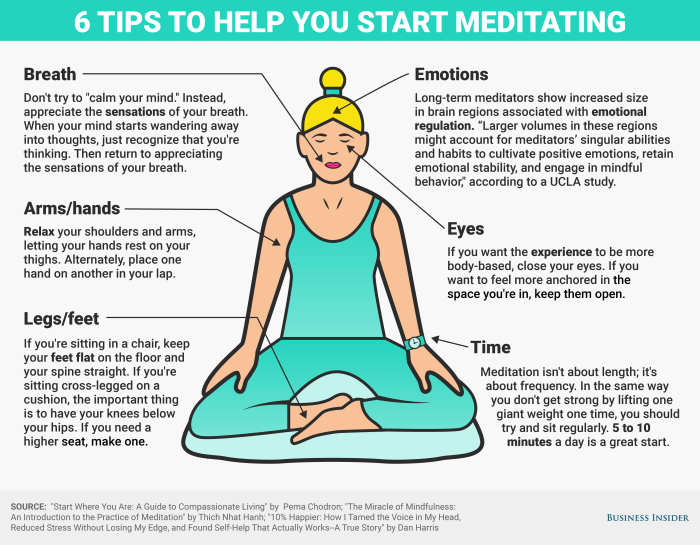Embark on a journey through the world of meditation techniques, exploring different methods and their benefits, all in a captivating and informative manner.
Discover the power of mindfulness, transcendental meditation, guided visualization, and loving-kindness meditation as we delve into each practice with insight and clarity.
Overview of Meditation Techniques

Source: shopify.com
Meditation is a practice that involves focusing the mind and eliminating the stream of thoughts that normally occupy our consciousness. The purpose of meditation is to achieve a state of deep relaxation and awareness, ultimately leading to a sense of peace and balance.There are several types of meditation techniques, each with its own unique approach and focus. Some common meditation techniques include:
Types of Meditation Techniques
- Mindfulness Meditation: Involves focusing on the present moment and observing thoughts and sensations without judgment.
- Transcendental Meditation: Involves repeating a mantra to transcend thought and achieve a state of pure awareness.
- Loving-Kindness Meditation: Involves cultivating feelings of love and compassion towards oneself and others.
- Body Scan Meditation: Involves systematically scanning the body for sensations and relaxing each part.
Each meditation technique offers unique benefits to those who practice them. Some of the benefits of regularly practicing meditation techniques include:
Benefits of Practicing Meditation Techniques
- Reduced stress and anxiety levels
- Improved focus and concentration
- Enhanced emotional well-being and resilience
- Increased self-awareness and mindfulness
- Promotion of overall mental and physical health
Mindfulness Meditation

Source: aboutmeditation.com
Mindfulness meditation involves focusing your mind on the present moment without judgment, allowing you to increase awareness of your thoughts, emotions, and sensations.
Step-by-step Guide for Mindfulness Meditation
- Find a quiet and comfortable place to sit or lie down.
- Close your eyes and take a few deep breaths to relax your body.
- Focus on your breath, noticing the sensation of each inhale and exhale.
- When your mind wanders, gently bring your attention back to your breath without judgment.
- Expand your awareness to other sensations in your body, sounds around you, or thoughts passing through your mind.
- Practice for a few minutes to start and gradually increase the duration as you feel more comfortable.
Examples of Mindfulness Meditation Techniques
- Body Scan: Focus on each part of your body, starting from your toes and moving up to your head, noticing any tension or sensations.
- Loving-Kindness Meditation: Send positive thoughts and well wishes to yourself, loved ones, and even difficult individuals.
- Walking Meditation: Pay attention to each step you take, feeling the ground beneath your feet and the movement of your body.
- Observing Thoughts: Simply observe your thoughts as they come and go, without getting caught up in them or attaching judgment.
Transcendental Meditation
Transcendental Meditation is a technique that involves sitting comfortably with closed eyes and silently repeating a mantra. This technique is said to promote a state of relaxed awareness and inner peace.
Origin and Principles
Transcendental Meditation, also known as TM, was developed by Maharishi Mahesh Yogi in the 1950s. The practice is based on ancient Vedic traditions and is designed to help individuals reach a state of pure consciousness.
- Transcendental Meditation focuses on the use of a mantra, a specific word or sound that is repeated silently during meditation.
- The goal of TM is to transcend thought and experience a state of restful alertness, allowing the mind to settle and become more peaceful.
- Practitioners of TM are encouraged to meditate for 20 minutes twice a day, ideally in the morning and evening, to experience the full benefits of the practice.
Comparison with Other Techniques
Transcendental Meditation differs from other meditation techniques in its emphasis on the use of a personalized mantra and the practice of effortless concentration. While mindfulness meditation focuses on being present in the moment and observing thoughts without judgment, TM aims to transcend thought altogether.
- Unlike mindfulness meditation, which encourages awareness of the present moment, TM seeks to go beyond conscious thought and access a deeper level of awareness.
- Some research suggests that TM may have unique benefits, such as reducing stress and improving overall well-being, when compared to other forms of meditation.
- While the effectiveness of TM compared to other techniques is still debated, many practitioners find this method to be a powerful tool for relaxation and self-discovery.
Guided Visualization

Source: tqn.com
Guided visualization is a meditation technique that involves focusing on a specific scenario or setting to create a mental image. It helps individuals relax, reduce stress, and enhance their overall well-being.
Tips for Effective Use of Guided Visualization Techniques
- Find a quiet and comfortable space where you can relax without distractions.
- Choose a guided visualization script or scenario that resonates with you.
- Start by taking deep breaths to calm your mind and body before beginning the visualization.
- Engage all your senses to make the visualization more vivid and immersive.
- Practice regularly to improve your ability to visualize and relax deeply.
Examples of Guided Visualization Scripts for Meditation
Here are a few examples of guided visualization scripts that you can use during meditation:
Imagine yourself walking through a peaceful forest. Feel the soft ground beneath your feet, smell the fresh pine scent in the air, and hear the gentle rustling of leaves in the breeze.
Picture yourself on a beautiful beach at sunset. Feel the warm sand between your toes, hear the soothing sound of the waves, and see the vibrant colors of the sky as the sun sets.
Visualize a serene mountain top. Feel the cool breeze on your skin, see the panoramic view of the valleys below, and hear the distant sounds of nature.
Loving-Kindness Meditation

Source: manhattanmentalhealthcounseling.com
Loving-Kindness Meditation, also known as Metta Bhavana, is a meditation practice that focuses on cultivating compassion, love, and kindness towards oneself and others. This technique aims to promote feelings of goodwill and empathy, leading to a sense of interconnectedness with all beings.
Step-by-Step Guide to Practice Loving-Kindness Meditation
To begin loving-kindness meditation, find a quiet and comfortable space where you can sit or lie down in a relaxed position. Close your eyes and take a few deep breaths to center yourself.
- Start by directing loving-kindness towards yourself. Repeat phrases like “May I be happy, may I be healthy, may I be safe, may I live with ease” while visualizing yourself surrounded by warmth and love.
- Next, extend these wishes to a loved one. Picture them in your mind and send them thoughts of love and well-being by saying, “May you be happy, may you be healthy, may you be safe, may you live with ease.”
- Continue by expanding this loving-kindness to neutral people, difficult individuals, and eventually to all beings in the world.
- Practice this meditation for about 10-15 minutes, gradually increasing the time as you become more comfortable with the practice.
Benefits of Loving-Kindness Meditation
- Enhances feelings of compassion and empathy towards oneself and others.
- Reduces feelings of anger, resentment, and judgment towards difficult individuals.
- Promotes a sense of interconnectedness and unity with all beings, fostering a greater sense of peace and harmony.
- Improves overall well-being by cultivating positive emotions and a more positive outlook on life.
Final Summary

Source: businessinsider.com
In conclusion, meditation techniques offer a pathway to inner peace and self-discovery, enriching our lives in profound ways. Embrace these practices to cultivate a sense of calm and mindfulness in your daily routine.